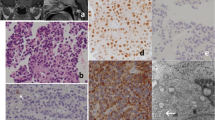Abstract
Pit-1 is a transcription factor that appears early in embryonic pituitary gland formation and is necessary for the development of somatotropes, lactotropes and thyrotropes. Steroidogenic factor-1 (SF-1) is another early appearing transcription factor that is involved in the development of gonadotropes. In this study we have compared RT-PCR analysis of hormone mRNA with traditional IHC for classification of 27 pituitary tumors and have evaluated the correlation of Pit-1 and SF-1 mRNA with hormone mRNA.
RT-PCR detected concordant hormone mRNA in 100% of GH IHC positive, 100% of PRL IHC positive, 33% of TSH IHC positive, and 93% of gonadotropin IHC positive tumors. IHC, however, was concordant in only 71% of GH mRNA positive, 78% of PRL mRNA positive, 17% of TSHβ mRNA positive, and 76% of FSHβ mRNA positive tumors.
Pit-1 mRNA was positive in 87% of tumors in which mRNA for GH, PRL or TSHβ was detected and in only 17% of GH, PRL and TSHβ mRNA negative tumors. SF-1 mRNA was positive in 94% of tumors in which mRNA for FSHβ was present and in no FSHβ mRNA negative tumors.
We conclude that RT-PCR analysis of hormone mRNA may be more sensitive than traditional hormone IHC for classification of pituitary tumors. Furthermore, tumor Pit-1 mRNA positively correlates with GH, PRL and TSHβ mRNA while tumor SF-1 mRNA correlates well with FSHβ mRNA. Combined analysis of hormone and transcription factor mRNA in pituitary tumor tissue may therefore be a more meaningful approach to pituitary tumor characterization.
Similar content being viewed by others
References
Shimon I, Melmed S. Pituitary tumor pathogenesis. J Clin Endocrinol Metab 1997;82:1675–1681.
Andersen B, Rosenfeld M. Pit-1 determines cell types during development of the anterior pituitary gland. A model for transcriptional regulation of cell phenotypes in mammalian organogenesis. J Biol Chem 1994;269:29335–29338.
Borrelli E. Pitfalls during development: Controlling differentiation of the pituitary gland. Trends in Genetics 1994;10: 222–224.
Parker KL, Schimmer BP. Steroidogenic factor 1: A key determinant of endocrine development and function. Endocrine Rev 1997;18:361–377.
Pellegrini-Bouiller I, Morange-Ramos I, Barlier A, Gunz G, Enjalbert A, Jaquet P. Pit-1 gene expression in human pituitary adenomas. Horm Res 1997;47:251–258.
Asa SL, Puy LA, Lew AM, Sundmark VC, Elsholtz HP. Cell type-specific expression of the pituitary transcription activator Pit-1 in the human pituitary and pituitary adenomas. J Clin Endocrinol Metab 1993;77:1275–1280.
Delhase M, Vergani P, Malur A, et al. Pit-1/GHF-1 expression in pituitary adenomas: Further analogy between human adenomas and rat SMtTW tumours. J Mol Endocrinol 1993;11:129–139.
Pellegrini-Bouiller I, Morange-Ramos I, Barlier A, et al. Pit-1 gene expression in human lactotroph and somatotroph pituitary adenomas is correlated to D2 receptor gene expression. J Clin Endocrinol Metab 1996;81:3390–3396.
Friend KE, Chiou YK, Laws ER, Beatriz M, Lopes Mb, Shupnik MA. Pit-1 messenger ribonucleic acid is differentially expressed in human pituitary adenomas. J Clin Endocrinol Metab 1993;77:1281–1286.
Inada K, Oda K, Utsunomiya H, et al. Immunohistochemical expression of Pit-1 protein in human pituitary adenomas. Endocr Pathol 1993;4:201–204.
Pelligrini I, Barlier A, Gunz G, et al. Pit-1 gene expression in the human pituitary and pituitary adenomas. J Clin Endocrinol Metab 1994;79:189–196.
Sanno N, Teramoto A, Matsuno A, Osamura Y. Expression of human Pit-1 product in the human pituitary and pituitary adenomas. Arch Pathol Lab Med 1996;120:73–77.
Sanno N, Teramoto A, Matsuno A, et al. Expression of Pit-1 and estrogen receptor messenger RNA in prolactin-producing pituitary adenomas. Mod Pathol 1996;9(5):526–533.
Sanno N, Teramoto A, Matsuno A, et al. In situ hybridization analysis of Pit-1 mRNA and hormonal production in human pituitary adenomas. Acta Neuropathol (Berl) 1996;91(3): 263–268.
Hamada K, Nishi T, Kuratsu J, Ushio Y. Expression and alternative splicing of Pit-1 messenger ribonucleic acid in pituitary adenomas. Neurosurgery 1996;38:362–366.
Lloyd RV, Jin L, Chandler WF, Horvath E, Stefaneanu L, Kovacs K. Pituitary specific transcription factor messenger ribonucleic expression in adenomatous and nontumorous human pituitary tissues. Lab Invest 1993;69:570–575.
Hoggard N, Callaghan K, Levy A, Davis JRE. Expression of Pit-1 and related proteins in diverse human pituitary adenomas. J Mol Endocrinol 1993;11:283–290.
Yamada S, Takahashi M, Hara M, et al. Pit-1 gene expression in human pituitary adenomas using the reverse transcription polymerase chain reaction method. Clin Endocrinol 1996;45:2263–2272.
Asa SL, Bamberger AM, Cao B, Wong M, Parker KL, Ezzat S. The transcription activator steroidogenic factor-1 is preferentially expressed in the human pituitary gonadotroph. J Clin Endocrinol Metab 1996;81:2164–2170.
Ikuyama S, Ohe K, Yoshiyuki S, et al. Follicle stimulating hormone-b subunit gene is expressed in parallel with a transcription factor Ad4BP/SF-1 in human pituitary adenomas. Clin Endocrinol 1996;45:187–193.
Wang AM, Doyle MV, Mark DF. Quantitation of mRNA by polymerase chain reaction. Proc Natl Acad Sci USA 1989; 86:9717–9721.
Simmons DM, Voss JW, Ingraham HA, et al. Pituitary cell phenotypes involve cell-specific Pit-1 mRNA translation and synergic interactions with other classes of transcription factors. Genes Dev 1990;4:695–711.
Sanno N, Inada K, Utsunomiya S, et al. Expression of Pit-1 product in human pituitaries: Histochemical studies using an antibody against synthetic human Pit-1 protein. Med Sci Res 1994;22:685–687.
Author information
Authors and Affiliations
Rights and permissions
About this article
Cite this article
McDermott, M.T., Haugen, B.R., Gordon, D.F. et al. Reverse Transcription Polymerase Chain Reaction Analysis of Pituitary Hormone, Pit-1 and Steroidogenic Factor-1 Messenger RNA Expression in Pituitary Tumors. Pituitary 2, 217–224 (1999). https://doi.org/10.1023/A:1009957411973
Issue Date:
DOI: https://doi.org/10.1023/A:1009957411973




